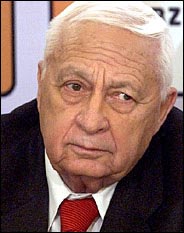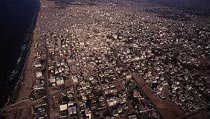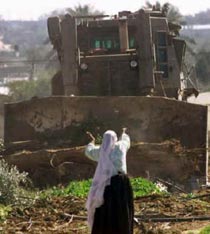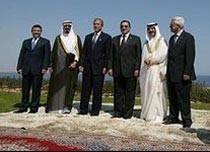| (insert your NIE or newspaper logo here) |
Weekly Online LessonOnline Lesson ArchiveGrade Level: 7-12
|
The Road Map & the Middle East
 Last week, Israeli Prime Minister Ariel Sharon took a bold step in the long war between his nation and the future state of Palestine. On Thursday, December 18, 2003, Sharon announced that if peace negotiations between them aren't settled within six months, then Israel vows to build walls to physically isolate itself from the Palestinians with the hope of reducing conflict and violence.
Last week, Israeli Prime Minister Ariel Sharon took a bold step in the long war between his nation and the future state of Palestine. On Thursday, December 18, 2003, Sharon announced that if peace negotiations between them aren't settled within six months, then Israel vows to build walls to physically isolate itself from the Palestinians with the hope of reducing conflict and violence.
The peace negotiations are to be based on a plan known as the "road map." If successful, the road map will lead to a Palestinian state by 2005. The plan was adopted in early June, but talks have stalled due to continued attacks between the Jewish and Arab populations.
While reducing violence and removing Jewish settlers would be welcome, the Palestinians are worried over where the walls would be laid. An Israeli barrier's current route carves off about 15 percent of the West Bank — land that Palestinians want for their future state.
What this means for Israelis, is that tens of thousands of them might be forced to move from their homes. These Jewish settlers are now angry at Sharon, because he pushed for the building of these communities after Israel occupied this land following the 1967 war.
As for the American government, it actively supports stability in the Middle East, including the road map. After all, the region links Africa, Europe and Asia, plus it's a primary energy supplier.
The Middle East has had a long, mixed history of prosperity, poverty and war, and the Israeli-Palestinian conflict is one reflection of this region's struggle for peace and security. So for this week's lesson, you'll look at life on all sides of the Israeli-Palestinian conflict. Then you'll see the big picture of how the road map is just one piece of the Middle East peace puzzle.
Israel & Palestine: The Unsettled Dispute
 Start your journey in the heart of this region's dispute — the Gaza Strip. Although this National Geographic site was published in 1996, such stories are still common here.
Start your journey in the heart of this region's dispute — the Gaza Strip. Although this National Geographic site was published in 1996, such stories are still common here.
To get a sense of this historical place, review the Maps (animated or non-animated). You can also see a Detailed Map of Gaza. How did World War I and World War II dramatically change the face of Palestine? What major events happened in 1947? 1967? 1993? Where are the Gaza Strip and the West Bank located?
Next, read the Story of the Gaza Strip, as told by photojournalist Alexandra Avakian. Read the Q&A text, or listen to the RealAudio clips. As you move through the page, click on the underlined topics to jump to summaries of them and click on thumbnail photos to view them larger.
How do the Palestinians fit into the history of the Middle East? Who are the Hamas, and what role have they played in these disputes? In what ways are the children affected? What was the Declaration of Principles, and did the signing parties stick with the agreement?
 Can you describe some of the effects so many years of war has had on the people and their communities? In what ways are daily routines and dreams of the future shaped by the area's political and social unrest?
Can you describe some of the effects so many years of war has had on the people and their communities? In what ways are daily routines and dreams of the future shaped by the area's political and social unrest?
Now that you've seen the dispute from a civilian lens, look at the militant side of The Battle for the Holy Land at PBS's Frontline site, published in April 2002. Click on the underlined terms for definitions.
Read the Introduction, and review the Map to familiarize yourself with where the major cities and populations are. Then land On the Ground to hear from Israeli Lt. Gen. Shaul Mofaz and Three Palestinian Militant Leaders.
Who do they label as "terrorists"? What does each side of this dispute ultimately want? In what ways do the key political figures, Yasser Arafat and Ariel Sharon, influence what happens on the ground?
Check out the timeline of events in The Cycle of Violence. What happened in July 2000, and what were some of the sticking points that prevented peace? How do these compare to today's obstacles? About how many times since 2000 have leaders come together for peace talks but were unsuccessful in resolving the dispute?
Lastly at this site, explore possible answers to the question, Can Anything End This? Read some of the articles in the sections, Can Anything End This Crisis? and Proposals for Resuming Peace Negotiations.
Who would like to see the Oslo Accords implemented and who would like to see a new plan signed and followed? Based on what you've learned, how might you propose a road map for peace in this region, and what historical events or principles would support your proposal?
The Middle East
 Although the dispute between the Israelis and the Palestinians is a significant conflict, it represents just one struggle over land, resources, political power and social identity that have occurred in this region for generations.
Although the dispute between the Israelis and the Palestinians is a significant conflict, it represents just one struggle over land, resources, political power and social identity that have occurred in this region for generations.
To find out more about what forces have influenced Middle Eastern peoples, explore the region using Global Connections: the Middle East at PBS. Begin by reviewing the different Maps and the Timeline of key events.
In what ways have Britain and the United Nations been involved in shaping borders and policies here? What were some of the important events related to Iraq, Iran (formerly Persia), Saudi Arabia, Egypt, Turkey, Lebanon, Syria, Qatar and the United Arab Emirates? Can you identify some of the different ethnic groups who live in this region?
Next, jump to the site's Explore a Theme section. As you browse each theme, you can click on underlined words to read the Glossary definition.
Start with the Geography of the area to read about why people originally settled this region and how these communities evolved. How has the region's primary source of "wealth" changed over time? In what ways have the geological features influenced where and how people live?
 Then browse the Religion and Culture sections. What are the "Abrahamic religions," and what ties do they have to the region and to each other? How do the languages spoken reflect the region's ethnic diversity?
Then browse the Religion and Culture sections. What are the "Abrahamic religions," and what ties do they have to the region and to each other? How do the languages spoken reflect the region's ethnic diversity?
Also read about the Middle East's Economics and Politics.
How did Europeans control trade in the Middle East? In what ways can political turmoil affect a nation's economy? How do governing principles in the region differ from those in the West and why? How do U.S. policies affect relationships in the Middle East?
Some Westerners may think that the Middle East is "behind the times," but this region has produced tremendous advances in Science and Technology over the years. For example, in what ways have Middle Eastern innovations contributed to medicine, astronomy and water management?
Do you think non-Middle Eastern leaders should continue to influence life and politics in the Middle East? Why or why not? What does the United States risk to gain or lose by being actively involved in the region's peace process?
Newspaper Activities
In a current issue of Targetnewspaper look for stories about the Israeli-Palestinian conflict. Have the leaders been able to restart peace negotiations? If so, does resolution over core issues seem possible? What other nations are involved in the peace talks? Is violence on the ground still common? What will happen if Sharon follows through with his promise to isolate Israel with walls? Alternatively, look for articles about other nations in the Middle East. What economic, social or political issues are highlighted in the news? How does it relate to the region's history or to other nations?
© Copyright 2003
Learners Online, Inc.
